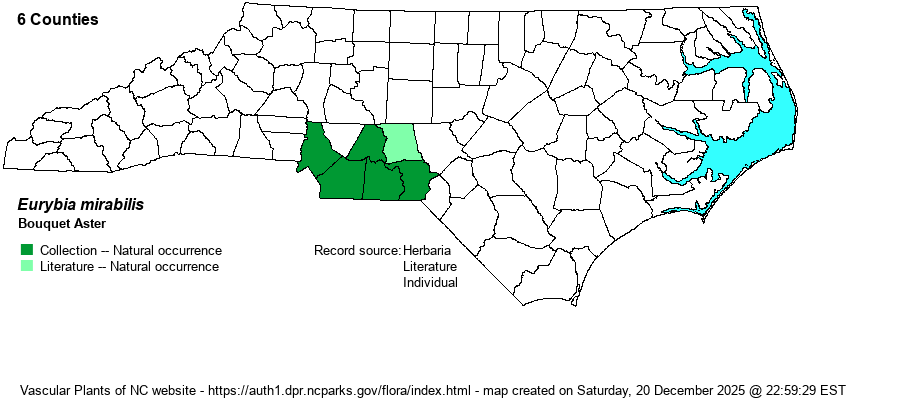| Author | (Torrey & A. Gray) G.L. Nesom | |
| Distribution | Restricted to the middle and lower southern Piedmont, north to Mecklenburg, Stanly, and Montgomery counties.
A quite small range; endemic to southern NC and central and western SC. | |
| Abundance | Despite it being a "rare" species, in NC it is uncommon to locally common. Most populations appear to be stable in terms of numbers of plants. The NCNHP has it on its Significantly Rare list. | |
| Habitat | Mesic, nutrient-rich soils of hardwood slopes, banks of brownwater rivers and streams, bottomlands. It favors circumneutral soils. |
| Phenology | Flowering and fruiting July-September. | |
| Identification | The genus Eurybia has been split from Aster (now Symphyotrichum). Variation among species of each genus requires several steps in a key to split members of the two genera apart (see genus key in Weakley 2018).
Plants grow about 2 feet tall, sometimes to 3 feet, with ovate, short-pointed leaves that have cordate bases on long stalks (stalks are much reduced or absent on upper leaves). Inflorescences tend to be flat-topped or shallowly rounded, rather few-headed, with white rays. Note the recurved tips of the flower bracts! White Wood-aster (E. divaricata) may grow near it, but it has the flower bracts tightly appressed, more strongly cordate leaf bases, and more sharply serrated leaves. | |
| Taxonomic Comments | Formerly known as Aster commixtus or A. mirabilis.
| |
| Other Common Name(s) | Piedmont Aster, Dwarf Aster | |
| State Rank | S3 | |
| Global Rank | G3 | |
| State Status | SR-T | |
| US Status | | |
| USACE-agcp | | |
| USACE-emp | | |

